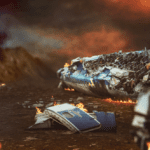 Crime
Crime  Crime
Crime  Technology
Technology 10 Hilariously Over-Engineered Solutions to Simple Problems
 Miscellaneous
Miscellaneous 10 Ironic News Stories Straight out of an Alanis Morissette Song
 Politics
Politics 10 Lesser-Known Far-Right Groups of the 21st Century
 History
History Ten Revealing Facts about Daily Domestic Life in the Old West
 Weird Stuff
Weird Stuff 10 Everyday Products Surprisingly Made by Inmates
 Movies and TV
Movies and TV 10 Actors Dragged out of Retirement for One Key Role
 Creepy
Creepy 10 Lesser-Known Shapeshifter Legends from Around the World
 Animals
Animals 10 Amazing Animal Tales from the Ancient World
 Gaming
Gaming 10 Game Characters Everyone Hated Playing
 Crime
Crime 10 Terrifying Serial Killers from Centuries Ago
 Technology
Technology 10 Hilariously Over-Engineered Solutions to Simple Problems
 Miscellaneous
Miscellaneous 10 Ironic News Stories Straight out of an Alanis Morissette Song
Who's Behind Listverse?

Jamie Frater
Head Editor
Jamie founded Listverse due to an insatiable desire to share fascinating, obscure, and bizarre facts. He has been a guest speaker on numerous national radio and television stations and is a five time published author.
More About Us Politics
Politics 10 Lesser-Known Far-Right Groups of the 21st Century
 History
History Ten Revealing Facts about Daily Domestic Life in the Old West
 Weird Stuff
Weird Stuff 10 Everyday Products Surprisingly Made by Inmates
 Movies and TV
Movies and TV 10 Actors Dragged out of Retirement for One Key Role
 Creepy
Creepy 10 Lesser-Known Shapeshifter Legends from Around the World
 Animals
Animals 10 Amazing Animal Tales from the Ancient World
 Gaming
Gaming 10 Game Characters Everyone Hated Playing
Top 10 Shocking Documentaries
As a visual medium, documentaries frequently succeed in portraying the unimaginable far better then any book alone could do. Beaming everything from the consequences of child abuse to the horrors of nuclear warfare into the homes of millions, the following infamous documentaries shock the viewer and challenge perceptions. Please note: Almost all the videos featured contain graphic and disturbing content, relevant to the topic at hand. Warning: some of these documentaries contain disturbing footage.
Following the struggle of three crack addicts, ‘High on Crack Street’ digs deep into the complex daily lives of individuals striving to obtain their next fix. From prostitution to pregnancies to STDs, we see the true dark side of drugs they don’t show you in school. There is something quite shocking about just how badly crack ruins lives. Unfortunately there is no happy ending to this story—six months after filming Boo Boo was still hooked on a $200 a day habit, Dicky was imprisoned and, sadly, Brenda died. A remarkable film about a horrific plague, ‘High on Crack Street’ is unwavering in it’s portrayal of crack addiction.
Add this disturbing documentary to your collection today! Buy High on Crack Street at Amazon.com!
Lying at the base of Mount Fuji, Aokigahara Forest has a rather unsettling reputation as a suicide hotspot . This documentary follows a geologist as he performs a walk through of the forest, looking for both those who have, and may soon, succumb to depression. Spotting an abandoned car in the parking lot on the way in, passing signs dissuading suicide, and taking an ill trodden path into the bewildering forest, it isn’t long before we’re shown our first images of forsaken souls—all of whom hang from Aokigahara’s thick ligatures. From this point onwards, it only gets worse. I encourage all with a strong heart to watch this bleak, but brief, portrayal of the utter desperation in full.
Vicious, ruthless, remorseless, brutal, fearless, violent, disturbed and callous are just some of the words which can be used to describe serial contract killer Richard “The Iceman” Kuklinski. ‘The Iceman Tapes’ attempts to take the viewer into the broken mind of a cold-blooded paranoid psycho-sociopath through a series of interviews conducted by psychiatrist Michael Baden. From his upbringing to his reasons, watching Kuklinski describe his atrocities in detail with little to no emotion is a truly unsettling, yet compelling, experience. In his own words: “I am what you call . . . a person’s nightmare.”
Own the complete documentary! Watch The Iceman Tapes: Conversation with a Killer for free with a Prime membership at Amazon.com!
Drawing the viewer in with an almost poetic charm, few films portray the intricacies of the Holocaust better then this 1955 French film, Nuit et Brouillard, or—to give it its English title—Night and Fog. Featuring the camps at Auschwitz and Majdanek, we are taken on an uncompromising, and unforgiving, journey through the encampments history, and the fate of its occupants. From construction to destruction, Nuit et Brouillard etches horrific images onto the minds of its viewers which will seldom leave their memory.
For all the propaganda and scaremongering that occurred during the Cold War, it is difficult for us to imagine the human effects of nuclear weapons—besides the massive loss of life, of course. We tend to imagine nukes as pulverizing all whom stand in it’s way, but a nuclear weapon doesn’t simply destroy, it poisons, it burns, it corrupts. Those unlucky enough not to be obliterated are left to suffer a horrific and painful death—often over months, years or even decades, rather then minutes or seconds. ‘Atomic Wounds’ takes us on an up close and personal trip to the victims of Nagasaki and Hiroshima, documenting the terrifying effects of atomic warfare on those who were not struck down in the initial cataclysm. It is difficult to watch this film without asking “how could we ever do this to our fellow man?” We often forget that the victims of Nagasaki and Hiroshima we’re living and breathing humans, just like you and I. We see a statistic. This film ensures that we remember that there is only misery under those numbers.
Apologies for the poor quality on the above video, ‘Conspiracy of Silence’ has never been released, and numerous parties have been attempting to prevent this documentary, espousing the perversion and abuse of power that occurs at the highest levels in society. A representation of how influence and wealth can be used for personal gain and the suppression of criminal acts, ‘Conspiracy of Silence’ takes us into the world we all know that exists, and yet hopes it does not.
A warning up front, ‘The Killing of America’ consistently provides the viewer with very real, and very graphic footage of criminal activity. From riots to outright murder, this documentary is far from shy of presenting the truth as is, with no sugar coating. “What truth?” you ask? Well, the fact that the United States was the most violent first world nation on earth. ‘The Killing of America’ attempts to understand why this was the case, and although it may seem outdated one should remember that the US is still one of the most violent first world nations on earth—despite the fact that violent crime has fallen considerably each year since it’s peak in the early 1990s. This documentary thus gives us an uncompromising look at america’s dark past—and perhaps also provides us with one piece of the puzzle that bugs us today.
What drives a man to kill and cannibalize an innocent woman? Well, why not ask such a man… in his own living room? ‘Interview with a Cannibal’ does just that, with the infamous case of Issei Sagawa—propelled to fame through his crimes, he was deemed insane by the courts and thus released without charge. A fascinating insight into the life of a man lost in his own fantasies, this documentary challenges perceptions about what humans are truly capable of—as well as allowing us to understand the path one must take to reside where he now sits.
Words simply cannot explain what is expressed in this BBC documentary. Put simply, Bulgaria has a serious problem with child abandonment, particularly of the disabled—and, worse yet, the government is apparently unable to care for them sufficiently. Recording numerous children over a nine month period, we are offered a unique insight into the appalling inner workings of a Bulgarian orphanage. With many of the children’s poor lives consisting mainly of sitting in a room rocking back and fourth amongst themselves, these children have little hope for the future: no education, no therapy… no help. The plight of an otherwise intelligent young lady known as Didi starkly highlights the failing of the Bulgarian system: she is classified as ‘untreatable’ and thrown amongst the disabled, despite being quite the opposite—a maddening position if you ask me, and her behavior soon reflects this fact as she eventually succumbs to rocking and self harm to burn away her days.
One may be happy to know that after being broadcast in the United Kingdom there was a public outcry which brought servitude for most of the children featured: the majority of which are now recovering in more suitable care. Didi attended a special boarding school and excelled in her classes. She now enjoys a relatively normal life, frequently visiting museums and art galleries. Besides from this, other EU nations have also put pressure on the Bulgarian government to reform the system and help these outcasts. The first part of a follow up documentary can be viewed here.
Child of Rage documents the horrific effects of sexual abuse upon a young child named Beth. Consisting primarily of short clips of Beth being interviewed by a clinical psychiatrist, we learn—from both Beth herself, and the additional research done by the TV crew—that she was sexually violated and neglected at a young age by her birth father. This has resulted in the emersion of reactive attachment disorder—a psychiatric condition which, in this case, can in many ways be compared to sociopathy, although their causes are radically different. Beth simply does not feel empathy, and she lacks the ability to connect with others—a product of her mind’s attempts to shut out and detach herself from her past abuse.
Within this film this young girl admits to engaging in highly sadistic, cruel, and often sexual acts upon her brother and animals, as well as just generally displaying a blatant disregard for the rights of others, as well as social norms—which includes the right to life. There is a certain poignancy in hearing a young child’s wishes to murder her parents, as well as her attempts to kill her brother. Demonstrating how abuse can turn innocent young individuals into brutal, remorseless killers, Child of Rage ultimately expresses hope that, if caught at a young enough age, reactive attachment disorder can be treated with rigorous therapy, and the damage reversed—thus bringing a conscience back to a child who would otherwise go through life without one. Beth’s final interview, where she breaks down in remorse for her past self, is truly a tear-jerker.








